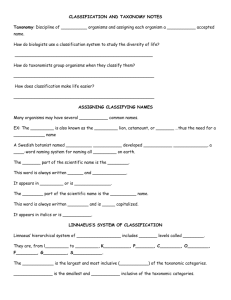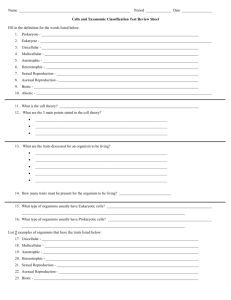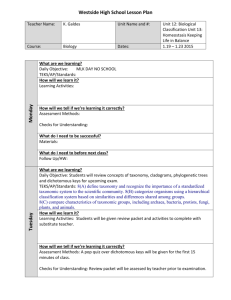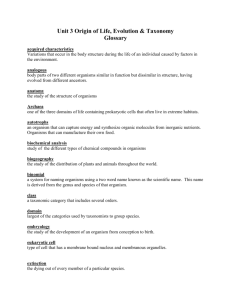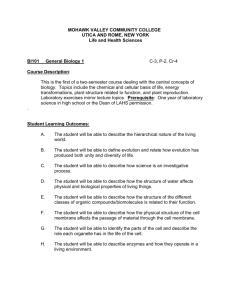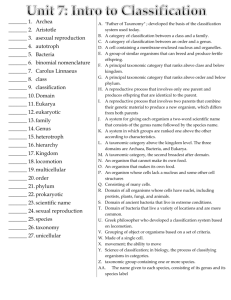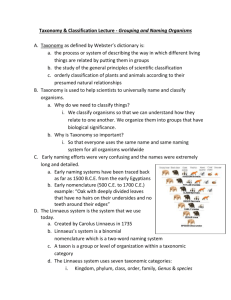Klein ISD Science Curriculum
advertisement
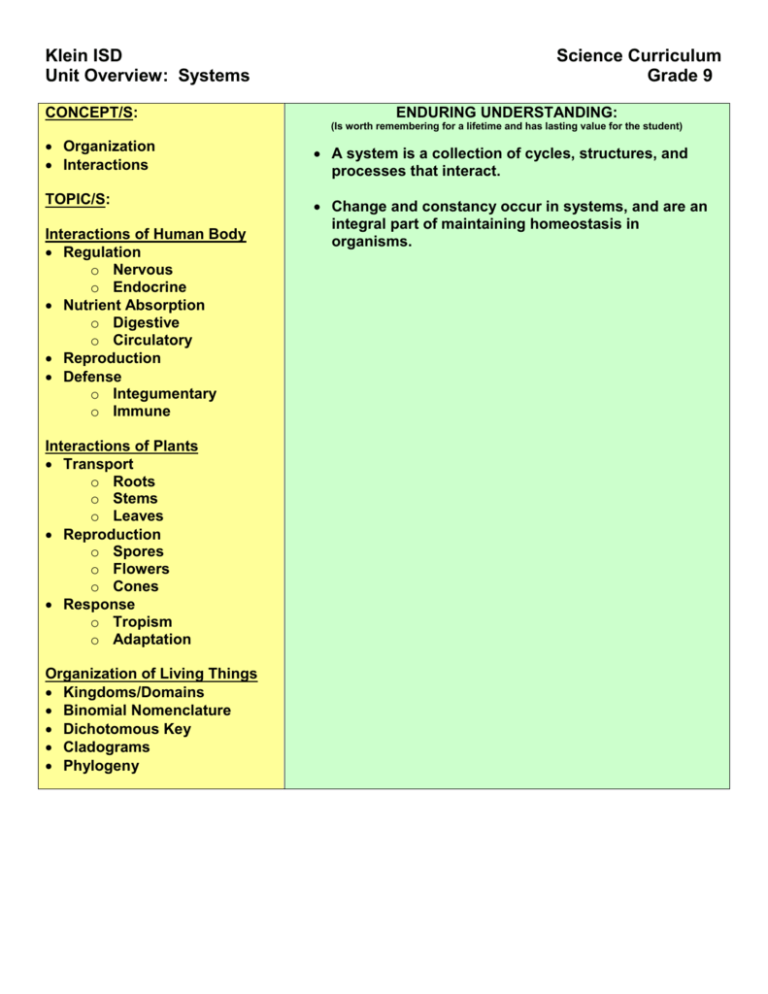
Klein ISD Unit Overview: Systems CONCEPT/S: Science Curriculum Grade 9 ENDURING UNDERSTANDING: (Is worth remembering for a lifetime and has lasting value for the student) Organization Interactions A system is a collection of cycles, structures, and processes that interact. TOPIC/S: Change and constancy occur in systems, and are an integral part of maintaining homeostasis in organisms. Interactions of Human Body Regulation o Nervous o Endocrine Nutrient Absorption o Digestive o Circulatory Reproduction Defense o Integumentary o Immune Interactions of Plants Transport o Roots o Stems o Leaves Reproduction o Spores o Flowers o Cones Response o Tropism o Adaptation Organization of Living Things Kingdoms/Domains Binomial Nomenclature Dichotomous Key Cladograms Phylogeny ESSENTIAL QUESTIONS: GUIDING QUESTIONS: (Universal questions worth contemplation and exploration by the student) (Fundamental queries that guide the search for student understanding) 1. How do you organize your closet? 2. What are some signs that indicate that you are sick? 1. What advantages are there for categorizing living things in both the Scientific Community and Public? 3. Does a plant always grow toward the sun? 4. How do plants help and harm you? 2. How does taxonomy use hierarchal classification systems to illustrate the relatedness of organisms? 3. How are plant structures such as roots, stems, and leaves, related to their functions? 4. How are animal structures such as blood, muscle, and epithelium related to their functions? 5. How do organs and organ systems work to perform the functions of regulation, nutrient absorption, reproduction, and defense? 6. How are microorganisms beneficial to the health of animals and plants, and to the ecosystems that they live in? TEKS/SEs CONTENT (TEKS) PROCESS (SE) The student will… By… (5)…know how an organism grows and the importance of cell differentiation. 5(B)…examining specialized cells, including roots, stems, and leaves of plants; and animal cells such as blood, muscle, and epithelium. (8)…know that taxonomy is a branching classification based on the shared characteristics of organisms and can change as new discoveries are made. 8(A)…defining taxonomy and recognizing the importance of a standardized taxonomic system to the scientific community. 8(B)…categorizing organisms using a hierarchical classification system based on similarities and differences shared among groups. 8(C)…comparing characteristics of taxonomic groups, including Archaea, bacteria, protists, fungi, plants, and animals. (10)…know that biological systems are composed of multiple levels. 10(A)…describing the interactions that occur among systems that perform the functions of regulation, nutrient absorption, reproduction, and defense from injury or illness in animals. 10(B)…describing the interactions that occur among systems that perform the functions of transport, reproduction, and response in plants. 10(C)…analyzing the levels of organization in biological systems and relate the levels to each other and to the whole system. (11)…know that biological systems work to achieve and maintain balance. 11(A)…describing the role of internal feedback mechanisms in the maintenance of homeostasis. 11(C)…summarizing the role of microorganisms in both maintaining and disrupting the health of both organisms and ecosystems. CONTENT VOCABULARY Interactions of Human Body Blood Defense from injury or illness Epithelium Muscle Nutrient absorption Reproduction Interactions of Plants Leaves Reproduction Response Roots Stems Transport Organization of Living Things Animals Archaea Bacteria Fungi Hierarchical classification system Importance of standardized taxonomic system Levels of organization Plants Protists Taxonomic groups Taxonomy COGNITIVE VOCABULARY Analyzing Categorizing Comparing Defining Describing Examining Recognizing STUDENT OBJECTIVE 5 E LESSONS Lesson 1: Lesson 2: Lesson 3: (“I can” statements should be displayed for students) I can: …identify and describe the specialized cells in plants, such as roots, stems and leaves. …identify and describe the specialized cells in animals, such as blood, muscle and epithelium. …define taxonomy and can recognize the importance of the taxonomic system. …categorize organisms into the classification system by their similarities and differences. …identify and compare the major characteristics of organisms in each Kingdom. …describe how systems work together to carry out processes such as regulation, nutrient absorption, reproduction, and defense from injury or illness in animals. …describe how plants transport nutrients, reproduce, and respond to their environment. …analyze the levels of organization and know the order from cell to organism. …relate each level of organization to the entire system as a whole. …describe what homeostasis is and how it works as an internal feedback mechanism. …summarize how bacteria can help and/or hurt organisms and ecosystems.
